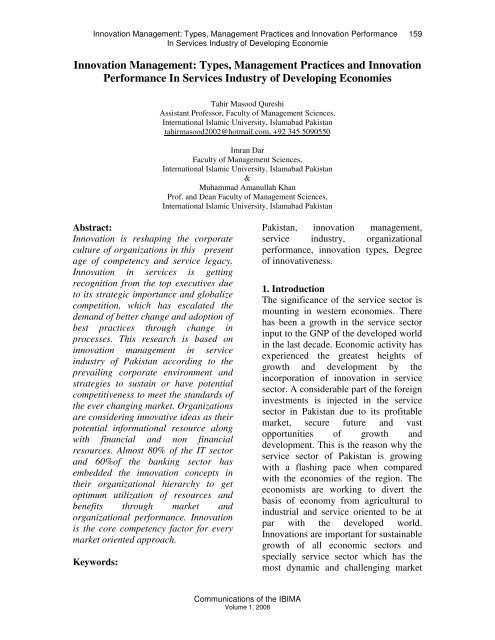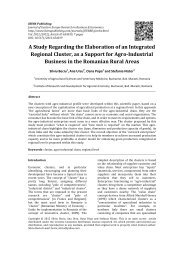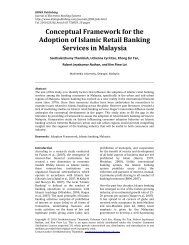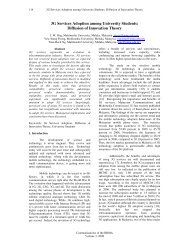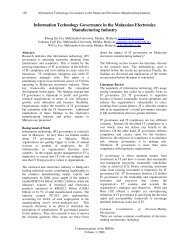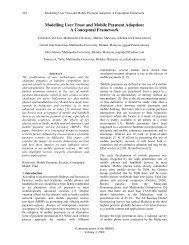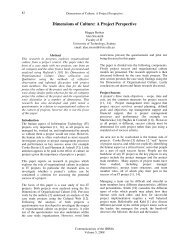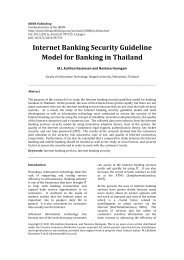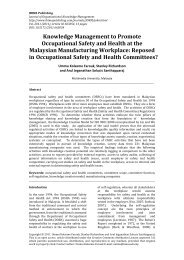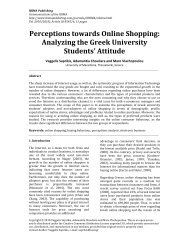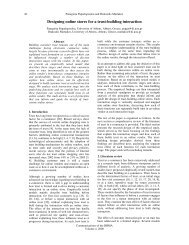Innovation Management: Types, Management ... - IBIMA Publishing
Innovation Management: Types, Management ... - IBIMA Publishing
Innovation Management: Types, Management ... - IBIMA Publishing
You also want an ePaper? Increase the reach of your titles
YUMPU automatically turns print PDFs into web optimized ePapers that Google loves.
<strong>Innovation</strong> <strong>Management</strong>: <strong>Types</strong>, <strong>Management</strong> Practices and <strong>Innovation</strong> Performance 159<br />
In Services Industry of Developing Economie<br />
<strong>Innovation</strong> <strong>Management</strong>: <strong>Types</strong>, <strong>Management</strong> Practices and <strong>Innovation</strong><br />
Performance In Services Industry of Developing Economies<br />
Tahir Masood Qureshi<br />
Assistant Professor, Faculty of <strong>Management</strong> Sciences,<br />
International Islamic University, Islamabad Pakistan<br />
tahirmasood2002@hotmail.com, +92 345 5090550<br />
Imran Dar<br />
Faculty of <strong>Management</strong> Sciences,<br />
International Islamic University, Islamabad Pakistan<br />
&<br />
Muhammad Amanullah Khan<br />
Prof. and Dean Faculty of <strong>Management</strong> Sciences,<br />
International Islamic University, Islamabad Pakistan<br />
Abstract:<br />
<strong>Innovation</strong> is reshaping the corporate<br />
culture of organizations in this present<br />
age of competency and service legacy.<br />
<strong>Innovation</strong> in services is getting<br />
recognition from the top executives due<br />
to its strategic importance and globalize<br />
competition, which has escalated the<br />
demand of better change and adoption of<br />
best practices through change in<br />
processes. This research is based on<br />
innovation management in service<br />
industry of Pakistan according to the<br />
prevailing corporate environment and<br />
strategies to sustain or have potential<br />
competitiveness to meet the standards of<br />
the ever changing market. Organizations<br />
are considering innovative ideas as their<br />
potential informational resource along<br />
with financial and non financial<br />
resources. Almost 80% of the IT sector<br />
and 60%of the banking sector has<br />
embedded the innovation concepts in<br />
their organizational hierarchy to get<br />
optimum utilization of resources and<br />
benefits through market and<br />
organizational performance. <strong>Innovation</strong><br />
is the core competency factor for every<br />
market oriented approach.<br />
Keywords:<br />
Pakistan, innovation management,<br />
service industry, organizational<br />
performance, innovation types, Degree<br />
of innovativeness.<br />
1. Introduction<br />
The significance of the service sector is<br />
mounting in western economies. There<br />
has been a growth in the service sector<br />
input to the GNP of the developed world<br />
in the last decade. Economic activity has<br />
experienced the greatest heights of<br />
growth and development by the<br />
incorporation of innovation in service<br />
sector. A considerable part of the foreign<br />
investments is injected in the service<br />
sector in Pakistan due to its profitable<br />
market, secure future and vast<br />
opportunities of growth and<br />
development. This is the reason why the<br />
service sector of Pakistan is growing<br />
with a flashing pace when compared<br />
with the economies of the region. The<br />
economists are working to divert the<br />
basis of economy from agricultural to<br />
industrial and service oriented to be at<br />
par with the developed world.<br />
<strong>Innovation</strong>s are important for sustainable<br />
growth of all economic sectors and<br />
specially service sector which has the<br />
most dynamic and challenging market<br />
Communications of the <strong>IBIMA</strong><br />
Volume 1, 2008
160 Tahir Masood Qureshi, Imran Dar, and Muhammad Amanullah Khan<br />
with less barriers and product service<br />
legacy. Organizations in the country are<br />
facing environmental, policy, structural,<br />
institutional and cultural weaknesses,<br />
which have constrained their ability to<br />
take full advantage of the rapidly<br />
advancing process of globalization and<br />
from innovation practices, but<br />
professionally and non professionally<br />
these practices are in action in<br />
organizations especially in the service<br />
sector, this research will be an attempt to<br />
explore the actual innovation types, the<br />
degree of innovative practices in<br />
different organizations and their<br />
contributions towards growth and<br />
development.<br />
It is, therefore, envisioned to explore<br />
innovative practices and their<br />
contribution towards organizational<br />
performance. Although in most of the<br />
developing countries the main obstacle<br />
of organizational profitability is the lack<br />
of professional use of innovative<br />
practices in product service development<br />
but struggle is, however, going on to<br />
find out best ways to utilize them.<br />
The main aim of this study is to examine<br />
the different types of innovation that are<br />
applicable in companies in the Pakistan<br />
services sector, the degree of<br />
innovativeness, the practices and<br />
barriers, associated to the pursuit of<br />
innovation and their relationship with<br />
company performance. Research study<br />
will include 35 service organizations for<br />
data/ information collection and analysis<br />
will be consisted on facts and figures<br />
provided by innovation managers, the<br />
views of employees will also be<br />
focalized.<br />
2. Literature Review<br />
2.1 <strong>Innovation</strong> types Radical,<br />
Incremental and Me-too innovation<br />
The future of culture of innovation on<br />
corporate level is based on the provision<br />
of conducive environment (Robert M.<br />
Price, 2007), contribution of the<br />
individuals in the growth of innovative<br />
ideas and self development which gives<br />
birth to a set of innovations which are<br />
radical, incremental and learnt from the<br />
competitors through proper manner<br />
recognized in the corporate world. These<br />
set of innovations (ideas, methodologies)<br />
become the value of the organization by<br />
supporting the corporate strategy<br />
(W.David, Chin Huat Ong et al.,<br />
2005).The source of pressure to innovate<br />
is the increase in complexity in the<br />
processes and global competition.<br />
Organizational excellence is born form<br />
the continuous improvement in<br />
processes, develop and maintain<br />
competitiveness in the ever changing<br />
environment (Pervaiz K. Ahmed, 1998).<br />
<strong>Innovation</strong>s on the basis of science have<br />
contributed to the global society for the<br />
past centuries. Research on innovation<br />
has three aspects like experimental<br />
observation of innovation processes and<br />
systems, critical analyses of the<br />
innovation theory, decision making<br />
skills based on innovation. <strong>Innovation</strong> is<br />
in its developmental stage and new types<br />
and forms of innovation disciplines are<br />
emerging as research on innovation is<br />
contributing to the knowledge of theory<br />
and operational processes (Ruud Smits,<br />
2002).<br />
2.2 Degree of innovativeness<br />
The clear evolution of the phases or<br />
aspects of innovation with respect to<br />
their impact on the organizational<br />
performance is crucial for effective and<br />
efficient benchmarking as it depicts the<br />
true picture of the indicators which<br />
Communications of the <strong>IBIMA</strong><br />
Volume 1, 2008
<strong>Innovation</strong> <strong>Management</strong>: <strong>Types</strong>, <strong>Management</strong> Practices and <strong>Innovation</strong> Performance 161<br />
In Services Industry of Developing Economie<br />
reveal about the degree of<br />
innovativeness and its impact on the<br />
performance of the organization. The<br />
effectiveness of the innovation is<br />
measured in terms of the responsive<br />
impact on the products and<br />
organizational processes which indicates<br />
the efficiency of innovation in the shape<br />
of organizational performance (G .Tor &<br />
L.Kathryn, 1994).<br />
Strategic direction is crucial to gain<br />
optimum benefits from innovation as it<br />
makes innovation the part of the<br />
organizational strategy. The degree to<br />
which this strategic vitality is recognized<br />
by the organizations can be judged by<br />
the quantum of responsibilities given to<br />
significant amount of staff in relation to<br />
their human resource and the verticals<br />
where that staff is placed in the<br />
organizational hierarchy (C. Angela, E.<br />
John, et al., 2001).<br />
This is the age of information<br />
technology, companies are changing<br />
rapidly and market competitiveness<br />
forces them to develop synergic relation<br />
between quality and productivity<br />
(Michael A. Allocca & Eric H. Kessler,<br />
2006).<br />
2.3 <strong>Innovation</strong> management practices<br />
The survey of large firms has proved<br />
that there are different requirements for<br />
managing radical and incremental<br />
innovations. Profitable radical<br />
innovations are more dominant in small<br />
medium enterprises as compared to large<br />
firms. Incremental innovations,<br />
involving improvements to processes,<br />
products and services in response to<br />
customer needs are focused (Oke A.,<br />
Burke G. et al., 2007).<br />
The greatest level of growth and vitality<br />
over the past decade in the economic<br />
activity is experienced in the service<br />
industry due to innovation in services.<br />
Academic interests in the innovation<br />
management sector are growing due to<br />
the growth of service sector by the<br />
introduction of innovative services and<br />
processes.<br />
The life cycle of innovation is to be<br />
taken into account through applying a<br />
whole set of techniques to have the risk<br />
analyses of the changes in cost, value,<br />
product and processes at organizational<br />
level (Frederic Tomala & Olivier<br />
Senechal, 2004).<br />
Studies on innovations in the service<br />
sector, however, have received little<br />
Research is gaining recognition about<br />
relationships between innovation types,<br />
the degree of innovativeness, innovation<br />
performance and innovation<br />
management practices.<br />
<strong>Innovation</strong> performance is based on<br />
radical product innovation and radical<br />
service innovation. Incremental<br />
innovations for products and for services<br />
are informally related to innovation<br />
performance. Formal practices are<br />
implemented in the development of<br />
radical innovations by studying the<br />
prevailing relationship between product<br />
and service innovativeness and<br />
innovation management practices in the<br />
organizations. The management systems<br />
for innovation processes are developed<br />
by analyzing the organization of<br />
innovation activities and management<br />
policies (Tuominen M., et al.,<br />
1999).Incremental innovations are to be<br />
recognized formally in the strategies and<br />
define formal practices for implementing<br />
these types of innovations. Service<br />
innovations are more visible in transport<br />
and retail sectors (Oke A., 2007).<br />
Ineffective deployment processes are the<br />
major hindrance in the way of<br />
innovation management and utilization<br />
of its benefits in the shape of innovation<br />
legacy through proper safeguarding of<br />
Communications of the <strong>IBIMA</strong><br />
Volume 1, 2008
162 Tahir Masood Qureshi, Imran Dar, and Muhammad Amanullah Khan<br />
corporate strategies by patents and<br />
recognition plus support from the top<br />
management to make innovation as the<br />
part of the corporate culture (Oke<br />
Adegoke, 2004).<br />
2.4 <strong>Innovation</strong> performance<br />
Organizational performance &<br />
Market performance<br />
<strong>Innovation</strong> is the source of potential<br />
competitiveness which safeguards<br />
service legacy and is utilized as a tool to<br />
go beyond the strength of the<br />
competitors. Innovative personals are<br />
considered assets of the company and<br />
competitive advantage of the<br />
organization is based on the idea<br />
generation and knowledge management<br />
of the organizations in collaboration<br />
with the professionals responsible for<br />
innovations. The nucleus of<br />
competencies of the modern business<br />
world is innovation management<br />
because companies surpass one another<br />
on the basis of degree of innovativeness<br />
in their processes, technology use and<br />
customer satisfaction mechanisms (Y.<br />
Carol et al., 2007).<br />
The performance of innovations depend<br />
on long term and development –focused<br />
planning which has strategic and<br />
visionary value in the organization and<br />
the products and services created<br />
through innovative processes. The vision<br />
and goals of innovation must be<br />
communicated affectedly throughout the<br />
organization.<br />
Interdepartmental communication is<br />
vital to accelerate innovations and<br />
innovative processes. The focus of<br />
managers is to be shifted from traditional<br />
approaches to innovation and knowledge<br />
management .It could be done by<br />
attracting, retaining and motivating the<br />
innovative personal. The management<br />
practices are to be aligned with corporate<br />
objectives regarding innovations.<br />
<strong>Innovation</strong> has pivotal role in gaining<br />
competitiveness for the organizations<br />
through unmatchable link with the<br />
economic activities which reflect the<br />
financial as well as non financial<br />
performance of the organization (D.<br />
Keith Denton, 1999).<br />
<strong>Innovation</strong> is the center of the<br />
organizational strategy. <strong>Innovation</strong> is the<br />
key to potential growth which build<br />
competitiveness. It needs supportive<br />
environment, risk taking behavior,<br />
merging into bigger units and allowing<br />
change in the current processes and<br />
organizational hierarchy (Bolko von<br />
Oetinger, 2004).<br />
The perceived organizational and market<br />
performance is assessed in the market<br />
place where innovative marketing<br />
techniques are applied to convert good<br />
ideas and products into sales and<br />
revenue. <strong>Innovation</strong>s are inevitable for<br />
maintaining sustainable growth and<br />
market competitiveness due to<br />
increasing dynamism in customer<br />
demands and technological development<br />
in the global economy. <strong>Innovation</strong><br />
management systems are applied to<br />
effectively promote innovative processes<br />
and prove their efficiency by getting<br />
maximum benefits out of them through<br />
restructuring of policies and<br />
communication channels. <strong>Innovation</strong> is<br />
closely linked with firm performance<br />
because it adds value to the processes<br />
and products. The innovative activities<br />
are measured on the basis of their value<br />
and degree of direct affect on the<br />
organizational performance. <strong>Innovation</strong><br />
is considered as the process of<br />
commercializing and extracting value<br />
from ideas and converting them in to<br />
benefits in the real market. The<br />
companies today compete on the basis of<br />
Communications of the <strong>IBIMA</strong><br />
Volume 1, 2008
<strong>Innovation</strong> <strong>Management</strong>: <strong>Types</strong>, <strong>Management</strong> Practices and <strong>Innovation</strong> Performance 163<br />
In Services Industry of Developing Economie<br />
new and improved added value products<br />
and services, processes and business<br />
methods.<br />
3. Research Methodology:<br />
3.1 Purpose of the Research Study:<br />
The objective of this paper is to analyze<br />
the impact of innovation on the service<br />
industry in Pakistan. The main findings<br />
of this research comprises of the<br />
relationship between innovation types,<br />
innovation management and their impact<br />
on organizational performance.<br />
3.2 Research Design:<br />
The research design was finalized on<br />
the basis of the interviews taken form<br />
executives of IT and Banking sector.<br />
Mail survey was adopted due shortage<br />
of time and resources. We received<br />
positive response from the targeted<br />
individuals. Most of the people related<br />
to academic professions and<br />
individuals having executive level<br />
were aware of the concept. The<br />
questions were designed in the<br />
simplest and common words were used<br />
instead of technical terms.<br />
3.3 Response Rate:<br />
Information was collected from the<br />
individuals who were responsible for<br />
innovative actives in the firm to have<br />
rock hard authenticity. The individuals<br />
were instructed to fill the questionnaire<br />
according to the prevailing<br />
conditions.Out of 250 questionnaires<br />
we got back only 145.Overall response<br />
rate was 58%.Statistuical tools as<br />
regression, correlation and mean were<br />
applied to have meaningful data.<br />
3.4 TMQ- <strong>Innovation</strong> Performance Research Model<br />
Organizational<br />
performance<br />
+<br />
+<br />
Market<br />
performance<br />
<strong>Innovation</strong><br />
<strong>Management</strong><br />
practices<br />
<strong>Innovation</strong> performance<br />
+ +<br />
+<br />
Degree of<br />
innovativeness<br />
<strong>Innovation</strong><br />
<strong>Types</strong><br />
Radical<br />
innovations<br />
Incremental<br />
innovations<br />
Me-too<br />
innovations<br />
Communications of the <strong>IBIMA</strong><br />
Volume 1, 2008
164 Tahir Masood Qureshi, Imran Dar, and Muhammad Amanullah Khan<br />
Equation tested is following:<br />
Equation2: y = α +β 1 (x 1 ) +β 2 ( x 2 ) + β 3 (x 3 ) +ε<br />
OP= α + β 1 (IT) + β 2 (DOI) + β 3 (IMP) +ε<br />
Where as :<br />
X 1 =IT= <strong>Innovation</strong> types<br />
X 2 = DOI=Degree of innovativeness<br />
X 3 = IMP=<strong>Innovation</strong> management practices<br />
Equation2: y = α +β 1 (x 1 ) +β 2 ( x 2 ) + β 3 (x 3 ) +ε<br />
MP= α + β 1 (IT) + β 2 (DOI) + β 3 (IMP) +ε<br />
Where as :<br />
X 1 =IT= <strong>Innovation</strong> types<br />
X 2 = DOI=Degree of innovativeness<br />
X 3 = IMP=<strong>Innovation</strong> management practices<br />
3.6 Hypothesis<br />
H1: There is a positive relationship<br />
between radical innovations and<br />
organizational performance.<br />
H2: There is a positive relationship<br />
between radical innovations and market<br />
performance of the organization.<br />
H3: There is a positive relationship<br />
between incremental innovations and<br />
organizational performance.<br />
H4: There is a positive relationship<br />
between incremental innovations and<br />
market performance.<br />
H5: There is a positive relationship<br />
between me-too innovations and<br />
organizational performance.<br />
H6: There is a positive relationship<br />
between me-too innovations and market<br />
performance.<br />
H7: There is a positive relationship<br />
between <strong>Innovation</strong> management practices and<br />
organizational performance.<br />
H8: There is a positive relationship<br />
between <strong>Innovation</strong> management practices<br />
and market performance.<br />
H9: There is a positive relationship<br />
between Degree of innovativeness and<br />
organizational performance<br />
H10: There is a positive relationship<br />
between Degree of innovativeness and<br />
market performance.<br />
Communications of the <strong>IBIMA</strong><br />
Volume 1, 2008
<strong>Innovation</strong> <strong>Management</strong>: <strong>Types</strong>, <strong>Management</strong> Practices and <strong>Innovation</strong> Performance 165<br />
In Services Industry of Developing Economie<br />
4. Research Findings<br />
The correlation of all the variables are<br />
shown in the Table.1 and correlations<br />
are recorded in Table.2 which<br />
describes that the highest value of<br />
correlation between<br />
Independent and dependent variables is<br />
between innovation management and<br />
market performance (0.82) and also<br />
between innovation management and<br />
organizational performance (0.86).<br />
<strong>Innovation</strong>, management has mean<br />
(3.67) and standard deviation (0.74).<br />
Table 1. Correlation of Variables<br />
OP MP RI II MT IM DOI<br />
OP 1.00<br />
MP 0.89 1.00<br />
RI 0.77 0.74 1.00<br />
II 0.70 0.60 0.68 1.00<br />
MT 0.68 0.61 0.58 0.81 1.00<br />
IM 0.86 0.82 0.79 0.67 0.67 1.00<br />
DOI 0.81 0.75 0.76 0.75 0.76 0.87 1.00<br />
Radical innovation has the highest<br />
correlation in innovation types with<br />
organizational performance (0.77) and<br />
market performance (0.74).Mean of<br />
radical innovation is (3.66) and<br />
standard deviation (0.57).The least<br />
affective is Mee-too innovation in<br />
innovation management having<br />
correlation (0.68) with organizational<br />
performance having mean (3.18) and<br />
standard deviation (0.60). It means that<br />
radical innovation in innovation types<br />
significantly increases the rate of<br />
organizational performance and market<br />
performance. Incremental innovation<br />
has correlation (0.60) with market<br />
performance having the lowest level of<br />
correlation. After innovation<br />
management, degree of innovation has<br />
the second influential affect on<br />
organizational performance and market<br />
performance having correlation (0.81)<br />
and (0.75) with mean (3.55) and<br />
standard deviation (0.70).<br />
Table 2. Mean and Standard Deviation<br />
Standard<br />
Mean Median Deviation<br />
OP 3.69 3.80 0.66<br />
MP 3.63 3.75 0.65<br />
RI 3.66 3.80 0.57<br />
II 3.39 3.40 0.63<br />
MT 3.18 3.20 0.60<br />
IM 3.67 3.83 0.74<br />
DOI 3.55 3.50 0.70<br />
Communications of the <strong>IBIMA</strong><br />
Volume 1, 2008
166 Tahir Masood Qureshi, Imran Dar, and Muhammad Amanullah Khan<br />
According to Table.2, The variable<br />
having the highest mean (3.67) is<br />
innovation management practices (IM)<br />
which proves that it is having the most<br />
powerful impact. Mee-Too innovation<br />
(MT) has mean (3.18) which depicts it<br />
to be the least affecting variable having<br />
minute contribution in organizational<br />
performance.<br />
Table 3. Regression<br />
Regression Statistics<br />
Adjusted R Square<br />
0.77 Coefficients P-value<br />
Intercept(OP) 0.30 0.09<br />
RI 0.23 0.01<br />
II 0.10 0.22<br />
MT 0.10 0.23<br />
IM 0.46 0.00<br />
DOI 0.06 0.52<br />
Table 4. Regression<br />
Regression Statistics<br />
Adjusted R Square<br />
0.69 Coefficients P-value<br />
Intercept(MP) 0.48 0.02<br />
RI 0.29 0.00<br />
II -0.07 0.48<br />
MT 0.13 0.19<br />
IM 0.50 0.00<br />
DOI 0.02 0.84<br />
The tables show the regression, p-<br />
values and coefficients of the<br />
variables.Table3.shows<br />
the<br />
relationship between organizational<br />
performance and other variables and<br />
Table 4 indicates the relationship<br />
between market performance and other<br />
dependent variables. Table 3. explains<br />
that 1 unit increases (0.46) units of<br />
innovation management and there is<br />
0% significance. <strong>Innovation</strong><br />
management increases the highest no<br />
units and also has the highest level of<br />
significance. Incremental innovation<br />
and Mee-too innovation increases<br />
(0.10) units of organizational<br />
performance with significance 22%<br />
and 23% with increase of 1 unit. This<br />
figure states that incremental<br />
innovation and Me-too innovation has<br />
the least positive affect on<br />
organizational performance.Table4.<br />
shows that 1 unit increase in<br />
innovation management increases<br />
(0.50) units with significance of 0%.1<br />
unit increase in DOI increases (0.02)<br />
units with significance of 84% which<br />
reflects that it the least affecting<br />
variable with respect to market<br />
performance.1 unit increase in RI and<br />
MT increases (0.29) and (0.13) units<br />
with the significance of about 0% and<br />
19%.<br />
5. Conclusion:<br />
It has been concluded from the research<br />
that the most influential impact on<br />
organizational performance and market<br />
Communications of the <strong>IBIMA</strong><br />
Volume 1, 2008
<strong>Innovation</strong> <strong>Management</strong>: <strong>Types</strong>, <strong>Management</strong> Practices and <strong>Innovation</strong> Performance 167<br />
In Services Industry of Developing Economie<br />
performance is made by the variables<br />
named as innovation management<br />
practices and radical innovation in<br />
innovation types having the highest<br />
values in tables of mean, coefficients<br />
and regression. The Adjusted R Square<br />
reveals that 0.77 and 0.69 percent of the<br />
variables are explained by Table3. and<br />
Table4.which show the regression<br />
statistics of MP and OP. Radical<br />
innovation has the greatest level of<br />
recognition among the individuals and<br />
executives who are aware of the<br />
prevailing concept and operational forms<br />
and level of intensity of innovation in<br />
the local market. Banking and IT sector<br />
are chosen for sampling are the most<br />
highly innovative and potential<br />
competitiveness driven sectors of the<br />
local economy. The relationship between<br />
innovation types, degree of<br />
innovativeness and innovation<br />
management practices reveals that<br />
radical innovation and innovation<br />
management practices have a major role<br />
in the changes in organizational as well<br />
as market performance. The interviews<br />
taken from the executives reveled that<br />
much has to be done in Pakistan. Almost<br />
80% of IT related companies and 60%<br />
of the banks are having some forms of<br />
innovation which are usually not named<br />
as innovation but those processes come<br />
under the definition of innovation due to<br />
there nature of effects on the corporate<br />
culture and organizational processes<br />
which is reflected in various<br />
performance reports of the company.<br />
The positive impacts of innovation are<br />
proved through survey and extensive<br />
literature review. <strong>Innovation</strong><br />
management and degree of<br />
innovativeness also have an influential<br />
impact as they characterize the intensity,<br />
direction, Risk-management and<br />
strategic as well as market value of the<br />
ideas and change in processes.<br />
Further Research:<br />
In future further research could be an<br />
organized and meticulous approach<br />
towards establishing a framework<br />
which depicts the relationship between<br />
innovation management systems and<br />
competency legacy of service oriented<br />
companies.<br />
References:<br />
Angela Cottam, John Ensor and<br />
Christine Band (2001). “A benchmark<br />
study of strategic commitment to<br />
innovation” European Journal of<br />
<strong>Innovation</strong> <strong>Management</strong>, Vol. 4, pp. 88-<br />
94.<br />
Burke.G, Oke. A and Myers. A. (2007).<br />
“<strong>Innovation</strong> types and performance in<br />
growing UK SMEs”, International<br />
Journal of Operations & Production<br />
<strong>Management</strong>, Vol. 27, No. 7, pp. 735-<br />
753.<br />
Bolko von Oetinger (2004). “Form idea<br />
to innovation: making creativity real”,<br />
Journal of business strategy, Vol. 25,<br />
No.5, pp. 35-41.<br />
Carol Yeh-Yun Lin and Mavis Yi-Ching<br />
Chen (2007). “Does innovation lead to<br />
performance? An empirical study of<br />
SMEs in Taiwan”, <strong>Management</strong><br />
Research News, Vol. 30, No. 2, pp. 115-<br />
132.<br />
D. Keith Denton (1999). “Gaining<br />
competitiveness through innovation”<br />
European Journal of <strong>Innovation</strong><br />
<strong>Management</strong>, Vol. 2, pp. 82–85<br />
David Wan, Chin Huat Ong, Francis<br />
Lee. (2005). “Determinants of firm<br />
innovation in Singapore”,<br />
Technovation”, Vol. 25, pp. 261–268.<br />
Robert M. Price (2007). “Infusing<br />
<strong>Innovation</strong> into Corporate Culture”,<br />
Communications of the <strong>IBIMA</strong><br />
Volume 1, 2008
168 Tahir Masood Qureshi, Imran Dar, and Muhammad Amanullah Khan<br />
Organizational Dynamics, Vol. xxx, No.<br />
xxx, pp. xxx–xxx.<br />
Frederic Tomala , Olivier Senechal.<br />
(2004). “<strong>Innovation</strong> management: a<br />
synthesis of academic and industrial<br />
points of view”, International Journal of<br />
Project <strong>Management</strong>, Vol. 22, pp. 281–<br />
287<br />
Michael A. Allocca and Eric H. Kessler<br />
(2006). “<strong>Innovation</strong> Speed in Small and<br />
Medium-Sized Enterprises” The Authors<br />
Journal compilation, Vol. 15, No. 3.<br />
Markku Tuominen, Petteri Piippo,<br />
Takaya Ichimura, Yoshio Matsumoto<br />
(1999). “An analysis of innovation<br />
management systemsÕ characteristics”<br />
Int. J. Production Economics, Vol. 60-<br />
61, pp. 135-143.<br />
Oke.A. (2007) “<strong>Innovation</strong> types and<br />
innovation management practices in<br />
service companies”, International<br />
Journal of Operations &Production<br />
<strong>Management</strong>’ Vol. 27, No. 6, pp. 564-<br />
587.<br />
Oke, Adegoke. (2004). “Barriers to<br />
innovation management in service<br />
companies”, Journal of Change<br />
<strong>Management</strong>, Vol. 4, No.1, pp. 31 – 44.<br />
Pervaiz K. Ahmed. (1998).<br />
“Benchmarking innovation best<br />
practice” Benchmarking for Quality<br />
<strong>Management</strong> & Technology, Vol. 5, No.<br />
1, pp. 45-58.<br />
Ruud Smits (2002). “<strong>Innovation</strong> studies<br />
in the 21st century: Questions from a<br />
user’s perspective” Technological<br />
Forecasting & Social Change, Vol. 69,<br />
pp. 861–883.<br />
Tor Guimaraes and Kathryn Langley,<br />
(1994). “Developing <strong>Innovation</strong><br />
benchmarks: An Empirical Study”,<br />
Benchmarking for Quality <strong>Management</strong><br />
& Technology, Vol. 1, No. 3, pp.3-20.<br />
Communications of the <strong>IBIMA</strong><br />
Volume 1, 2008
<strong>Innovation</strong> <strong>Management</strong>: <strong>Types</strong>, <strong>Management</strong> Practices and <strong>Innovation</strong> Performance 169<br />
In Services Industry of Developing Economie<br />
A SURVEY ON<br />
<strong>Innovation</strong> management: <strong>Types</strong>, management practices and<br />
innovation performance in services industry of Pakistan<br />
Dear Respondent!<br />
I am research associate at International Islamic University Islamabad, conducting a<br />
research on “<strong>Innovation</strong> management: <strong>Types</strong>, management practices and innovation performance in<br />
services industry of Pakistan” and have designed this questionnaire to collect data from<br />
professionals working in the vicinity of service Industry. The data collected will be<br />
used and reported in aggregate form; no individual responses will be referred or quoted.<br />
The information you furnish will be treated as confidential.<br />
The objective of this research survey is to identify and explain the growing<br />
performance of organizations due to innovative practices. The results of this study will<br />
facilitate the service industry to address the fact that causes service organizations<br />
growth and will help to design effective strategies to for future goals achievement.<br />
You are requested to take 10 minutes out of your busy schedule to fill this<br />
questionnaire that comprises two parts. Please fill both parts completely. Your<br />
cooperation is highly appreciated. If you need findings of this research please send a<br />
request to TQ@tahirmasood.com<br />
Part A<br />
Please tick the appropriate checkbox below.<br />
Life of organization in years:<br />
< 10 10-20<br />
20-30 30+<br />
No. of employee in organization:<br />
- - - - - - - - - - - - - - - - -<br />
Highest Level of Education of<br />
employees:<br />
Bachelors<br />
Masters<br />
MS/M.Phil<br />
PhD<br />
Avg. income level of employees:<br />
20,000-30,000 31,000-<br />
40,000<br />
41,000-50,000<br />
5s1,000+<br />
Manager’s experience in this<br />
organization:<br />
Less than year 6-10 yrs.<br />
1-5 yrs. 10 or<br />
above<br />
Years in this industry:<br />
Less than year 6-10 yrs.<br />
1-5 yrs. 10 or above<br />
Part B<br />
Please encircle the appropriate number against each statement, according to the scale given<br />
below.<br />
Scale<br />
Strongly Disagree<br />
1<br />
Disagree<br />
2<br />
Indifferent/Neutral<br />
3<br />
FEED BACK FORM<br />
Agree<br />
4<br />
Strongly Agree<br />
5<br />
Organization Name:<br />
______________________________________________<br />
Communications of the <strong>IBIMA</strong><br />
Volume 1, 2008
170 Tahir Masood Qureshi, Imran Dar, and Muhammad Amanullah Khan<br />
Total Employees:<br />
Org. Life in years:<br />
______________________________________________<br />
______________________________________________<br />
Rating Criteria<br />
INNOVATION TYPES<br />
1 2 3 4 5<br />
Strongly Agree Neutral Disagree Strongly<br />
agree<br />
disagree<br />
Radical<br />
Compared to other organizations that do the same kind of work, how would you compare<br />
performance over the last three years in terms of:<br />
your organization’s<br />
1. Changes are made to the product services<br />
at the grass root level. 1 2 3 4 5<br />
2. Formal strategies are formed for the<br />
implementation. 1 2 3 4 5<br />
3. Educating and training personnel for this innovation 1 2 3 4 5<br />
4. Manuals and documents accurately explain<br />
the implementation and operation of the innovation 1 2 3 4 5<br />
5. <strong>Innovation</strong>s made during the last three years<br />
were perceived to be new to the industry in which<br />
the company operates. 1 2 3 4 5<br />
Incremental<br />
Compared to other organizations that do the same kind of work, how would you compare<br />
performance over the last three years in terms of:<br />
your organization’s<br />
1. Manuals and documents accurately explain the<br />
implementation and Operation. 1 2 3 4 5<br />
2. New products are made by modifying<br />
the existing products. 1 2 3 4 5<br />
3. Educating and training of workforce. 1 2 3 4 5<br />
4. Enhancement in the existing capabilities is done by<br />
restructuring of the processes or part of them 1 2 3 4 5<br />
5. There are formal training programs for<br />
skill development. 1 2 3 4 5<br />
Communications of the <strong>IBIMA</strong><br />
Volume 1, 2008
<strong>Innovation</strong> <strong>Management</strong>: <strong>Types</strong>, <strong>Management</strong> Practices and <strong>Innovation</strong> Performance 171<br />
In Services Industry of Developing Economie<br />
Me-too<br />
Compared to other organizations that do the same kind of work, how would you compare<br />
performance over the last three years in terms of<br />
your organization’s<br />
1. New products are made by modifying the<br />
product services of the competitors. 1 2 3 4 5<br />
2. The product services and work processes are<br />
directly affected by the strategies of competitors. 1 2 3 4 5<br />
3. Educating and training personnel. 1 2 3 4 5<br />
4. Informal management practices are associated<br />
with the pursuit of me-too innovations. 1 2 3 4 5<br />
5. Employee and customer responses are valued in restructuring<br />
and adopting the innovations of the competitors. 1 2 3 4 5<br />
INNOVATION PERFORMANCE<br />
PERCEIVED ORGANIZATIONAL PERFORMANCE<br />
Compared to other organizations that do the same kind of work, how would you compare<br />
performance over the last three years in terms of:<br />
your organization’s<br />
1. Increase in new products and product services. 1 2 3 4 5<br />
2. Strengthening of new processes of production and delivery. 1 2 3 4 5<br />
3. Exploring of new markets. 1 2 3 4 5<br />
4. Increase in new sources of supply. 1 2 3 4 5<br />
5. Achievements regarding Market competitiveness<br />
and sustainable growth. 1 2 3 4 5<br />
PERCEIVED MARKET PERFORMANCE<br />
Compared to other organizations that do the same kind of work, how would you compare<br />
performance over the last three years in terms of:<br />
your organization’s<br />
1. Productive marketing of products or services. 1 2 3 4 5<br />
2. Increase in growth in sales. 1 2 3 4 5<br />
3. Increase in Profitability. 1 2 3 4 5<br />
4. Increase in Market Share. 1 2 3 4 5<br />
INNOVATION MANAGEMENT<br />
Compared to other organizations that do the same kind of work, how would you compare<br />
performance over the last three years in terms of:<br />
your organization’s<br />
Communications of the <strong>IBIMA</strong><br />
Volume 1, 2008
172 Tahir Masood Qureshi, Imran Dar, and Muhammad Amanullah Khan<br />
1. Our organizational vision ,strategies and values<br />
about innovation are clear to the employees. 1 2 3 4 5<br />
2. Senior management accountable for<br />
new product results. 1 2 3 4 5<br />
3. Monitoring, Ensuring effectiveness and efficiency<br />
of innovative activities . 1 2 3 4 5<br />
4. Top management is fully committed to support<br />
innovation activities and strategies. 1 2 3 4 5<br />
5. New initiatives are aligned with the overall<br />
business strategy. 1 2 3 4 5<br />
6. Goals for innovation are communicated effectively<br />
throughout the company.. 1 2 3 4 5<br />
DEGREE OF INNOVATIVENESS<br />
Compared to other organizations that do the same kind of work, how would you compare<br />
performance over the last three years in terms of:<br />
your organization’s<br />
1. Encouraging innovative<br />
employees by reward method. 1 2 3 4 5<br />
2. Ability to attract, retain and motivate<br />
innovative employees has increased. 1 2 3 4 5<br />
3. Employees and customer responses are valued in the<br />
development of product and product service innovations. 1 2 3 4 5<br />
4. Modifications are done in existing products/services and<br />
line extension to meet customer demands and serving<br />
new markets. 1 2 3 4 5<br />
. .<br />
Communications of the <strong>IBIMA</strong><br />
Volume 1, 2008
<strong>Innovation</strong> <strong>Management</strong>: <strong>Types</strong>, <strong>Management</strong> Practices and <strong>Innovation</strong> Performance 173<br />
In Services Industry of Developing Economie<br />
Copyright © 2008 by the International Business Information <strong>Management</strong> Association. All rights reserved. No part or all<br />
of this work should be copied or reproduced in digital, hard, or any other format for commercial use without written<br />
permission. To purchase reprints of this article please e-mail: admin@ibima.org<br />
Communications of the <strong>IBIMA</strong><br />
Volume 1, 2008


